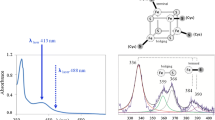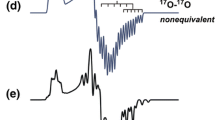Abstract
Selenium centered radical cations generated by the reaction of hydroxyl radicals with three different types of selenium compounds belonging to the classes of selenoamino acids, diselenides and selenoethers were studied by pulse radiolysis coupled with transient absorption detection. Nature, absorption spectrum, lifetime and reactivity of these selenium radicals were compared with the radical cations from sulfur analogues. The observed distinct differences in these two types of radicals have been highlighted.



Similar content being viewed by others
References
Stadtman TC (1996) Selenocysteine. Annu Rev Biochem 65:83–100
Priyadarsini KI, Singh BG, Kunwar A (2013) Current developments on synthesis, redox reactions and biochemical studies of selenium antioxidants. Curr Chem Biol 7:37–46
Rotruck JT, Pope AL, Ganther HE, Swanson AB, Hafeman DG, Hoekstra WG (1973) Selenium: biochemical role as a component of glutathione peroxidase. Science 179:588–590
Wessjohann LA, Schneider A, Abbas M, Brandt W (2007) Selenium in chemistry and biochemistry in comparison to sulfur. Biol Chem 388:997–1006
Kuntić VS, Stanković MB, Vujić ZB, Brborić JS, Uskoković-Marković SM (2013) Radioprotectors—the evergreen topic. Chem Biodivers 10:1791–1803
Andreassen CN, Grau C, Lindegaard JC (2003) Chemical radioprotection: a critical review of amifostine as a cytoprotector in radiotherapy. Sem Radiat Oncol 13:62–72
Douki T, Cadet J (2008) Radiation-induced damage to DNA: from model compounds to cell. In: Spotheim-Maurizot M, Mostafavi M, Douki T, Belloni J (eds) Radiation chemistry—From basics to applications in material and life sciences, chap. 12. EDP Sciences, Les Ulis, p 177
Zheng S, Newton GL, Gonick G, Fahey RC, Ward JF (1988) Radioprotection of DNA by thiols: relationship between the net charge on a thiol and its ability to protect DNA. Radiat Res 114:11–27
Asmus KD, Bonifacic M (1999) Sulfur centered reactive intermediates as studied by radiation chemical and complementary techniques. In: Alfassi ZB (ed) S-centered radicals, chap. 6. Wiley, Hoboken, p 141
Lanzalunga O, Lapi A (2012) Recent photo-and radiation chemical studies of sulfur radical cations. J Sulfur Chem 33:101–129
Asmus KD (1979) Stabilization of oxidized sulfur centers in organic sulfides. Radical cations and odd-electron sulfur-sulfur bonds. Acc Chem Res 12:436–442
Asmus KD, Bahnemann D, Fischer Ch-H, Veltwisch D (1979) Structure and stability of radical cations from cyclic and open-chain dithia compounds in aqueous solutions. J Am Chem Soc 101:5322–5329
Mukherjee AJ, Zade SS, Singh HB, Sunoj RB (2010) Organoselenium chemistry: role of intramolecular interactions. Chem Rev 110:4357–4416
Mishra B, Priyadarsini KI, Mohan H (2006) Effect of pH on the one-electron oxidation of organoselenium compounds in aqueous solutions. J Phys Chem A 110:1894–1900
Mishra B, Kumbhare LB, Jain VK, Priyadarsini KI (2008) Pulse radiolysis studies on reactions of oxidizing radicals with selenocystine derivatives. J Phys Chem B 112:4441–4446
Mishra B, Sharma A, Naumov S, Priyadarsini KI (2009) Novel reactions of one-electron oxidized radicals of selenomethionine in comparison with methionine. J Phys Chem B 113:7709–7715
Singh BG, Thomas E, Kumakura F, Iwaoka M, Priyadarsini KI (2010) One-electron redox processes in a cyclic selenide and selenoxide: a pulse radiolysis study. J Phys Chem A 114:8271–8277
Prabhu P, Bag PP, Singh BG, Jain VK, Iwaoka M, Priyadarsini KI (2011) Functional group dependent antioxidant activities of aliphatic selenoethers. Free Radic Res 45:461–468
Singh BG, Thomas E, Sawant S, Takahashi K, Dedachi K, Iwaoka M, Priyadarsini KI (2013) Radical cations of aromatic selenium compounds: role of Se···X non-bonding interactions. J Phys Chem A 117:9259–9265
Upadhyay J, Sharma ML, Navathe CP, Toley MA, Shinde SJ, Nadkarni SA, Sarkar SK (2012) Development of high-voltage pulse-slicer unit with variable pulse duration for pulse radiolysis system. Rev Sci Instrum 83:024709. doi:10.1063/1.3685245
Arnold AP, Tan KS, Rabenstein DL (1986) Nuclear magnetic resonance studies of the solution chemistry of metal complexes. 23. Complexation of methylmercury by selenohydryl-containing amino acids and related molecules. Inorg Chem 25:2433–2437
Chopade SM, Phadnis PP, Wadawale A, Hodage AS, Jain VK (2012) Synthesis and characterization of (ethylenediamine)/(diammine)platinum(II) coordinated to seleno ligands containing carboxylic acid functionality. Inorg Chim Acta 385:185–189
Hiller K-O, Masloch B, Gobl M, Amus K-D (1981) Mechanism of the OH-radical induced oxidation of methionine in aqueous solution. J Am Chem Soc 103:2734–2743
Hiller K-O, Amus K-D (1983) Formation and reduction reactions of a-amino radicals derived from methionine and its derivatives in aqueous solutions. J Phys Chem 87:3682–3688
Haung ML, Rauk A (2004) Reactions of one-electron-oxidized methionine with oxygen: an ab initio study. J Phys Chem A 108:6222–6230
Metanis N, Keinan E, Dawson PE (2006) Synthetic seleno-glutaredoxin 3 analogues are highly reducing oxidoreductases with enhanced catalytic efficiency. J Am Chem Soc 128:16684–16691
Elliot AJ, McEachern RJ, Armstrong DA (1981) Oxidation of amino-containing disulfides by Br 2- and OH radicals. A pulse radiolysis study. J Phys Chem 85:68–75
Bobrowski K, Pogocki D, Schoneich C (1998) Oxidation of (carboxyalkyl) thiopropionic acid derivativesby hydroxyl radicals. Mechanism and kinetics. J Phys Chem A 102:10512–10521
Bobrowski K, Pogocki D, Schoneich C (1993) Mechanism of the OH radical-induced decarboxylation of 2-(alkylthio)ethanoicacid derivatives. J Phys Chem 97:13677–13684
Singh BG, Nadkarni S, Jain VK, Priyadarsini KI (2015) Effect of alkyl chain length on the one-electron oxidation of selenocarboxylic acids: implication of their antioxidant ability. RSC Adv 5:66621–66627
Acknowledgments
The authors are thankful to Dr. V. K. Jain and his group members for synthesizing the selenium compounds.
Author information
Authors and Affiliations
Corresponding author
Rights and permissions
About this article
Cite this article
Priyadarsini, K.I., Singh, B.G. Selenium Centered Radicals: How Do They Differ from Sulfur Centered Radicals?. Proc. Natl. Acad. Sci., India, Sect. A Phys. Sci. 86, 459–464 (2016). https://doi.org/10.1007/s40010-016-0308-7
Received:
Revised:
Accepted:
Published:
Issue Date:
DOI: https://doi.org/10.1007/s40010-016-0308-7




